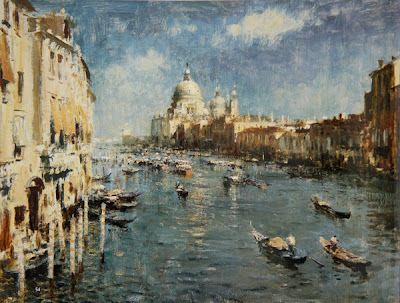 |
| Frederick Mulhaupt 1871-1938, lived in and painted Gloucester, Massachusetts. |
There are now over a thousand posts in this blog. When one writes a book, it is a reasonable assumption as you write page 342 that the reader has previously read page 40. But in a blog people just parachute in anywhere they damn well please. I get a lot of e-mail queries that I have answered before or written about a year or years ago (have I really been doing this for years?) it was to be a one year project, you know. Keep those questions coming, it's not a problem, I ignore some of them anyway, or snap off a quick return to the interrogator alone. I get some questions that really help me to know what to write about and inform me when I have been aphotic when I want so to be limpid. Here is an example of a question like that resulting from my last post on premixing the color of your light.
Dear, Mr. Stape
Does this premixed light color have white in it, or is it a color or mixture of colors without white?
Deb Pilatory
Yes of course it does. I should have said that. The premixed color should be mostly white in fact, The premixed color should be high key, like the light itself, real high key.
The blog started out with me explaining the most basic information about painting and studio knowledge. I progressed through ever more complex subjects like design, color, tree anatomy, the art business, framing, American painting, a woman giving birth to rabbits in Elizabethan England and the curious narrative of Dirk Van Assaerts. There is a whole lot back there and some of it is useful. If you have the time, I urge you to explore the blog backwards, that is, starting from its beginning and working forward. It should take you about six to eight weeks. There is no index. Even I have no idea what all is in those archives.
 |
| Antonio Cirino 1889-1983 Rockport, Massachusetts artist |
THERE IS ALWAYS AN ANSWER TO EVERY PAINTING PROBLEM, EVEN THOUGH YOU MIGHT NOT KNOW IT.
I might not know that answer, but there is one. If Willard Metcalf, Rembrandt, or John Sargent were to sit in front of my canvas they could rapidly fix its' problems. So if I knew what they would have done, I might know at least one answer to the problem. Often there ARE several. Sometimes the answer can be found through careful observation and analysis, but just as often the answer lies in invention, design, obfuscation or rearrangement of the elements of the view.
For me a painting is finished when I have solved all of its' problems. In old movies physicists worked on multiple blackboards stretched about the walls of a classroom, writing endless equations and mathematical claptrap until they reached that last blackboard and did finally solve the equation. This is the process that lead to the discovery of flubber .
When I don't know the answer to a problem in a painting I begin plugging in solutions, what if I soften it all up or subordinate this passage to that one? I try a change, and if it doesn't help I take it out with the side of my knife and try something else. I have stood in front of a painting (particularly seascapes) and tried solution after solution for WEEKS. There are thousands of decisions in a single painting.
A painting has to be pretty much all "right". The viewer won't tolerate much unconvincing drawing or unpleasant design flaws, nor will he waste much time on a painting that is merely accurate or ordinary. Folks are easily bored, at least the ones who spend real money on art. The more expensive the art gets the smarter the customers seem to become in the traditional painting world. Oddly, the opposite is true in the modern art world.
----------------------------------------------------------------------------------------------------
If you would like to know about the upcoming July workshop in New Hampshire please
click Here. I have included the cost of the workshop and information on the location in the White Mountains. I can teach you a whole lot, and probably save you years of screwing around. Why torture yourself ? Don't get left behind! You are worth it! Everyone's doing it. Act now.
The workshop takes place at a historic, wooden 19th century Inn in the White mountains with a view that is astounding, and all we have to do is paint. I park my car and forget it for the whole time I am there. I knock myself out from breakfast till bedtime to make sure that the workshop is as intense and useful as I can possibly make it.


















